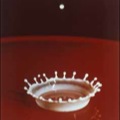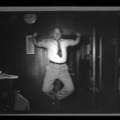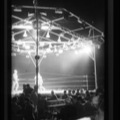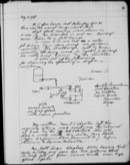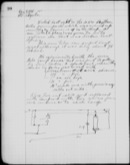Popular Interest: 1932 – 1941
In 1932, Edgerton was promoted to assistant professor at the Institute and he and his student and colleague, Kenneth J. Germeshausen, saw the first commercial model of their stroboscope hit the market.
During the late 1930s, Edgerton spent more and more time outside the laboratory. His photographs of stage shows, like the Follies, and sports events captured the imagination of news photographers. One photojournalist in particular, George Woodruff, worked closely with Edgerton. Woodruff helped to get the strobe accepted as an indispensable piece of the photojournalist’s camera kit. Below you’ll find photos of the Louis / Conn Fight, 1941.
When a photo taken with Edgerton’s strobe during a 1940 track meet was released over the wire, photographers and the public alike were amazed. Speedray photographs, as they were nicknamed, ushered a new era in sports photography.
One of Edgerton’s milk-drop photographs, titled Coronet, was included in the Museum of Modern Art’s first photography exhibition in 1937. That same year, he began designing studio strobes for Gjon Mili, who became a well-known photographer for Life magazine. At the request of Kodak, Edgerton set up a booth at the 1939 World’s Fair in New York City, complete with a baseball-shooting cannon that allowed visitors to take their own strobe pictures. In 1939, Edgerton also published Flash! Seeing the Unseen by Ultra-High-Speed Photography, a collection of his photographs. It was an instant bestseller.
Then, in 1940, MGM invited Edgerton to make a stroboscopic high-speed motion picture with comedian Pete Smith. The ten-minute short, Quicker ’n a Wink, won an Oscar.

